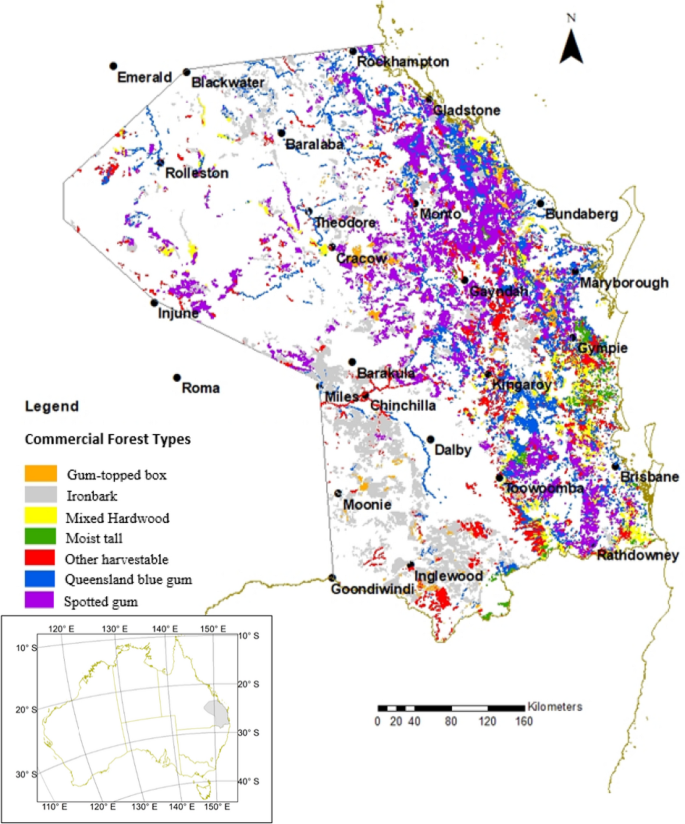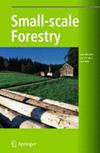Timber Production Opportunities from Private Native Forests in Southern Queensland
IF 1.8
3区 农林科学
Q2 FORESTRY
引用次数: 0
Abstract
Abstract Historically, Queensland’s private native forests have supplied between 40 and 70% of the hardwood resource to the state’s primary processors. Hardwood timber production from state-owned native forests and plantations in Queensland has decreased substantially in recent decades, increasing the hardwood timber industry’s reliance on private native forests. However, timber production opportunities from these forests are poorly understood. This study assessed the future wood supply capacity from private native forests in southern Queensland assuming alternative levels of landowner interest in management for timber production and willingness to invest in silvicultural treatment. Commercial and harvestable private native forests in southern Queensland were classified into six forest types and their spatial distributions were assessed. Potential growth rates for each forest type were estimated based on available literature and expert opinion, and their ability to supply logs to industry with and without silvicultural treatments was projected. Commercial and harvestable private native forests were found to cover an area of approximately 1.9 M ha in southern Queensland, of which spotted gum (693,000 ha) and ironbark (641,500 ha) forest types are most common. The private native forest estate is distributed over 17,665 landholdings (LotPlans), with 17% of these accounting for 66% of the commercial and harvestable resource. Most private native forests have not been actively managed for timber production and are in poor condition. Nevertheless, they presently have the potential to supply between about 150,000 and 250,000 m 3 of logs to industry per annum. Silvicultural treatments were found to have the potential to increase the mean annual increment of these forests by a factor of between two and four, indicating substantial opportunities to increase harvestable log volumes in the medium and long-term. Private native forests in southern Queensland could potentially more than compensate for the supply gap left by the declining area of state-owned native forests that are available for timber harvesting. Actual forest management performed and log volumes supplied to market will depend on the forest management decisions of thousands of individual landholders, which are influenced by their heterogeneous management objectives, the policy environment, perceptions of sovereign risk, timber markets and the long payback periods in forestry. An accommodating forest policy environment and landholder willingness to invest in forest management could maintain and potentially increase private hardwood log supply to industry, which would support farm income diversification and regional employment opportunities.

南昆士兰私人原生森林的木材生产机会
从历史上看,昆士兰州的私人原生森林为该州的初级加工商提供了40%至70%的硬木资源。近几十年来,昆士兰州国有原生森林和种植园的硬木木材产量大幅下降,增加了硬木木材行业对私人原生森林的依赖。然而,人们对这些森林的木材生产机会知之甚少。本研究评估了昆士兰州南部私人原生森林未来的木材供应能力,假设土地所有者对木材生产管理的兴趣和投资造林治疗的意愿不同。将昆士兰南部的商业和可采伐的私人原生森林划分为6种森林类型,并对其空间分布进行了评估。根据现有文献和专家意见估计了每种森林类型的潜在生长率,并预测了它们在有无造林处理的情况下向工业提供原木的能力。商业和可采伐的私人原生森林被发现覆盖了昆士兰南部约190万公顷的面积,其中斑点桉树(693,000公顷)和铁树皮(641,500公顷)森林类型最常见。私人原生森林地产分布在17,665块土地上(LotPlans),其中17%占商业和可采收资源的66%。大多数私人原生森林没有得到木材生产的积极管理,状况很差。然而,它们目前有潜力每年向工业供应约15万至25万立方米的原木。研究发现,造林处理有可能使这些森林的年平均增长量增加2至4倍,这表明在中期和长期内有大量机会增加可采伐的原木量。昆士兰州南部的私人原生森林可能会弥补可供采伐木材的国有原生森林面积减少所留下的供应缺口。实际进行的森林管理和向市场供应的原木数量将取决于成千上万个土地所有者的森林管理决定,这些决定受其不同的管理目标、政策环境、对主权风险的认识、木材市场和林业的长期回收期的影响。宽松的森林政策环境和土地所有者投资森林管理的意愿可以维持并可能增加私人硬木原木对工业的供应,这将支持农业收入多样化和区域就业机会。
本文章由计算机程序翻译,如有差异,请以英文原文为准。
求助全文
约1分钟内获得全文
求助全文
来源期刊

Small-Scale Forestry
FORESTRY-
CiteScore
3.10
自引率
6.70%
发文量
39
审稿时长
>12 weeks
期刊介绍:
Emerging from discussions within IUFRO’s Small-scale Forestry group, Small-scale Forestry was originally published as Small-scale Forest Economics, Management and Policy in 2002, with a view to providing an international forum for publishing high quality, peer-reviewed papers on pure and applied research into small-scale forestry. Although of particular interest to the global research community, the journal is also relevant to both policy makers and forest managers.
The scope of the journal is necessarily quite broad, given the range of issues relevant to small-scale forestry. These include the social, economic and technical dimensions of farm, family, non-industrial, agro- and community forestry. Papers are accepted on the basis that they relate specifically to forestry at this scale, and that they are based on high quality research using accepted quantitative and/or qualitative methodology.
Empirical, theoretical, modeling, and methodological papers are all welcome. The following research areas are particularly relevant to the journal:
-the role of small-scale forestry in rural development-
financial modeling and decision support systems-
enhancing return from non-wood products-
social impacts of small-scale forestry-
marketing, forest co-operatives and growers organizations-
role and effectiveness of government support and subsidies-
innovative research techniques-
education and extension-
certification-
silvicultural, wood harvesting and processing techniques and technologies-
impediments to small-scale forestry development-
monitoring socio-economics-
forest management behaviour and timber supply
 求助内容:
求助内容: 应助结果提醒方式:
应助结果提醒方式:


